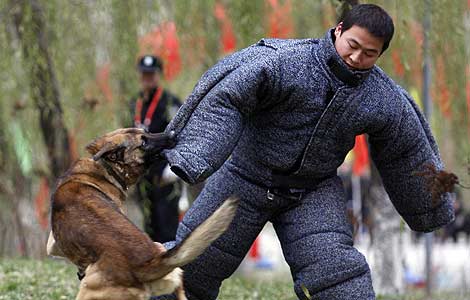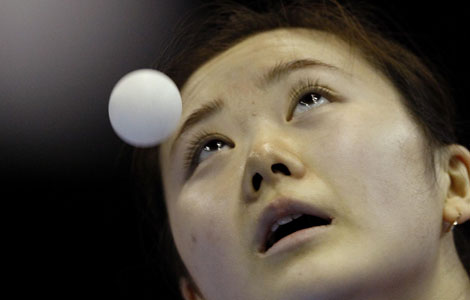Caught up in the jade craze
Updated: 2011-11-30 10:10
By Wei Tian (China Daily)
|
|||||||||
Her destination is Hetian, a remote city on the west end of China's territory where a riverbed emerges every spring as the snow melts, carrying jade pebbles down from the Kunlun Mountains.
The river, known as the Yurungkash or White Jade, is the headwater of Hetian's jade industry and has made the city a mecca for Wang and other dealers, collectors and speculators.
Although their enthusiasm was nearly the same, the prospectors who flocked to Hetian showed no reverence for something long considered sacred.
"The situation was most serious in 2006, when there were more than 8,000 excavating machines and 50,000 people digging along the 30-kilometer-long riverbed day and night, trying their luck," Wang said. "People would invest hundreds of thousands of yuan buying machines and hiring workers, but all the effort would pay off once they found a sizable jade pebble."
A small village sprung up along the river, with hundreds of tents and cook shops scattered around the digging site. The garbage they produced piled up, and their excavation reshaped the river, causing flood hazards.
The frenzy was stopped in 2007 when local government dispersed the illegal residents and banned any more mechanized exploration on the riverbank to prevent further environmental damage.
"But the restriction has only made the jade price increase even faster, because it significantly reduced production and pushed the scarcity value of the existing pieces even higher," Wang said.
"There will always be supply, only the digging now goes underground. Even with helicopters patrolling the area, some people still find a way to get access, under cover of river dredging projects, for instance."
The value of a jade pebble of acceptable quality can triple even before it is shipped out of Hetian, Wang said.
Off the market
"Top-quality Hetian jade is always bought directly by collectors from Beijing or Shanghai, or goes into the hands of jade-carving masters in Yangzhou," Wang said. "Only the next-best pieces are carved locally and for us local dealers."
But even when the second-best jade arrives at one of Wang's three fancy stores in Urumqi, a pebble the size of a 1 yuan coin comes with at least a five-figure price.
"Believe it or not, very few of them are now negotiable in price. People who really want to buy top-grade pieces do not care about the prices at all," Wang said. "You just don't know how rich some people are."
For many dealers like Wang, the real problem is to provide quality products to meet the demand. Very little good jade returns to circulation once sold, because people keep their collections off the market while -prices are rising.
"Earlier this year, there was a businessman from Wenzhou who brought 30 million yuan with him, hoping he could buy some masterpieces, but he returned disappointed," Wang said.
Wang has even contacted old customers to try to buy back their pieces, usually offering a 20 percent premium on the original price, but has found few takers.
That's understandable, given that even showing off your jade has become risky.
"The rules are, if someone is holding your jade and intends to appropriate it for himself, he can ask you to name a price and then pay for it," said Wei Dongyun, an experienced jade collector.
"It always happens at a dinner table with your friends, colleagues or a superior. You can hardly name a decent price to these people for fear of losing mianzi (face), but have to let it go," Wei said.
"So you'd better keep it low key when you get a masterpiece unless you're ready to make it a gift," he said.
On other occasions, Hetian jade is purchased for a purpose. "Our products were mostly bought by businessmen as a gift for their friends or business partners," Tong Xiaoyan said.
"No ordinary people would buy a jade article that costs a year's salary."
Tong is a saleswoman at Tianshan Department Store in one of Urumqi's most luxurious shopping malls. She used to work at a counter that sells diamonds, but applied to move to the jade counter "simply because the Hetian jade is much more expensive, and is a good way to make more commission".
"The genuine Hetian jades are already unaffordable for regular customers," she said. "If you have bought a nice-looking piece for just several hundred yuan, there is a great chance that you were cheated" - that the jade was imported.
Filling the low end
Xinjiang, as a popular tourist destination, attracts millions of people who would like to take home several jade articles as souvenirs. But their budgets, maybe just several thousand yuan, are trifling to the sellers.
A gap between the surging prices of genuine Hetian jade and growing demand at the low end has boosted imports from overseas.
"The volume of imported jade is enough to make every Chinese a jade wearer," said Li Yanjun, deputy head of art appraisal at the Ministry of Culture. "The majority of imports are from Russia or South Korea."
Total jade production in Hetian five years ago was about 10 tons. Jade imports from Russia alone exceeded 500 tons.
"Jade does not share the same cultural identity abroad as it does in our country," Li said. "The majority of their production is for export to China."
A growing supply from abroad will eventually bring down prices in the low-end market, Li said. Korean jade sells for just 800 yuan a kilo.
Although Hetian jade could still maintain its value, it's hard for ordinary eyes to distinguish between the genuine article and its imported imposter. Some forgers even paint color on jade to give it a weatherworn look and sell it as a precious pebble.
Priceless?
There is an old saying that "you can put a price on gold, but not one on jade". Some say it means that jade is priceless; others suggest it's valueless because jade isn't traded on a public market like gold or other metals.
Another saying, that "one should collect gold in troubled times, but jade in a flourishing age," applies to the huge price increase for Hetian jade in China's economic boom and period of excess liquidity.
"When the inflation rate remains high and restrictions are put on property investment, collections such as jade articles are some of the few legal investment channels with a promising return," Li said.
Qiu Zhili, a professor in the Gem Testing and Research (Appraisal) Center at Sun Yat-Sen University, offered another reason for the price increase. "We used to evaluate the price of jade just by its material value, while neglecting its social and environmental costs," such as the rising price of labor and stricter environmental protections.
But Qiu said that little room remains for further appreciation because the price has already put the market out of the mainstream and supply remain robust.
According to data from the Xinjiang Gem Association, the entire reserve of nephrite is 220,000 to 280,000 tons. Even though it is not as valued as pebble jade, the supply could last miners 160 more years at an exploitation rate of about 150 tons annually.
But jade dealers like Wang Wenhua remain confident that the price will keep increasing. She said as much while trying to make a sale to a tourist.
"Jade pebbles are non-renewable so they will for sure be more valuable," she said, "so pick one before it's too late.
"Not satisfied? No problem. I've got thousands more for you to choose from."











